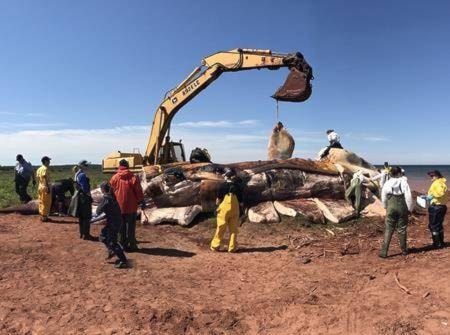HALIFAX — Injuries suffered by at least two of six North Atlantic right whales found floating lifeless in the Gulf of St. Lawrence appear to be consistent with ship strikes, marine mammal experts say.
Tonya Wimmer of the Marine Animal Response Society said Tuesday that the preliminary findings of necropsies on three of the whales indicate that two of them sustained blunt traumas that caused extensive bruising along their sides and internal hemorrhaging.
A third died after becoming snarled in fishing rope that wrapped around one flipper and inside its mouth.
She said the team of federal fisheries officials, veterinarians and other marine experts who were part of the necropsies in P.E.I. couldn’t yet say conclusively what caused the deaths as they await results from biological testing on the animal’s tissue. Experts are set to release a final report within the next two months.
Still, Wimmer said the information so far seems consistent with a collision with a vessel of some sort — one of the most lethal hazards for the endangered animals.
“The animal was obviously struck by something large, what it could be we don’t know,” she said in Halifax. “When we’ve seen that in the past, it has been on animals where there have been vessel collisions, but for these two we don’t know for a fact because no one saw these animals getting struck.”
The six North Atlantic right whales — among the most endangered large mammals on Earth — were found dead and decomposing in waters north of Prince Edward Island and southeast of Quebec’s Gaspe Peninsula last month. It’s not clear whether necropsies will be done on the other animals since some may have disappeared.
Pierre-Yves Daoust of the Atlantic Veterinary College in P.E.I. led the necropsies and said they discovered internal hemorrhaging confined to the thoracic cavity and some of the soft tissues.
“That suggests there may have been some major shearing forces that had ruptured blood vessels and caused fatal internal bleeding,” he said. “What we saw is consistent with blunt trauma and therefore a ship strike … but we can never completely rule out the possibility of some odd changes that may have happened after death.”
Still, he said the lack of a conclusive cause of death shouldn’t prevent officials from working to prevent future ship strikes while intensifying the research being done on the animals, which were hunted to the brink of extinction decades ago. The loss of six North Atlantic right whales represents about one per cent of the estimated 525 endangered animals now in existence.
“We cannot wait to have another half dozen right whales killed either this summer or next summer before we start addressing this potential cause of mortality,” he said.
The loss of so many right whales so quickly was probably last seen when whaling decimated their population in the 19th century, said Mark Baumgartner at the Woods Hole Oceanographic Institute on Cape Cod. He also said the deaths should be a call to do more to protect the animals when possible.
Wimmer said more needs to be done to identify the whales’ migratory routes and habitats so they can be protected against ship traffic and fishing activity. She said one of the whales — a 13-metre-long female around 11 years old — had fishing line and local buoys on it, so they may be able to determine where it travelled by locating the fisherman.
